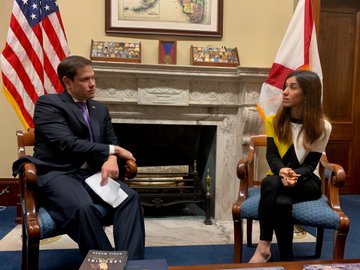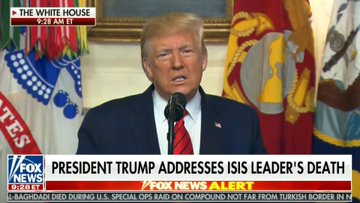
On Friday, January 10th, the U.S. State Department released a statement signaling their position to stay in Iraq, in defiance of the long standing Iraqi demands requesting the removal of the illegal U.S. occupation. This came seven days after the U.S.’s assassination of the Commander of the Al-Quds brigaide of the IRGC, Qassem Soleimani, and his close friend and comrade in struggle, Abu Mahdi al-Muhandis. The U.S.’s action in assassinating the two most powerful fighters of Daesh in Iraq highlighted the stubbornness of the U.S. as asserting its position as an occupying power in Iraq.
Jamal Ja'far Muhammad Ali Al Ibrahim, better known as Abu Mahdi al-Muhandis, was born in Basra, southern Iraq in 1954 to an Iranian mother and an Iraqi father. His nom-de-guerre is a combination of “Abu Mahdi,” or “Father of Mahdi,” a traditional Arab title referring to the name of his eldest child, and “al-Muhandis,” a nickname literally meaning “the engineer,” stemming from his graduation from engineering school in 1977. Following the Iranian revolution of 1979, al-Muhandis fled to the newly Islamic Republic during Saddam Hussein’s rise to power. Hussein also waged a heavy crackdown of the mainly Shiite Islamic Da’wa party, of which the young al-Muhandis was a member.
Over the years, a-Muhandis would perfect his expertise in organized resistance and take it home to Iraq as a part of the Badr Corps. He was key in his involvement and leadership in fighting the U.S. occupation following the 2003 American invasion and destabilization of Iraq. He was a founding leader of the Kata’ib Hezbollah militia, which was a main faction in fighting against the U.S. armed forces’ presence in Iraq post-2006.
In 2009, U.S. Executive Orders (E.O.) 13438 and 13224 placed sanctions on al-Muhandis for his leadership in resistance against the U.S. invasion, claiming to target him for “threatening the peace and stability of Iraq and the Government of Iraq.” The U.S. that day also placed Kata’ib Hezbollah in the designation as a foreign terrorist organization, which at that point would mark the group a target and threat to the U.S.’s interests in occupying and looting the country.
A little known member of Iraqi parliament post 2005, al-Muhandis largely ignored the public limelight characteristic of political life, instead remaining committed towards armed struggle. The late al-Muhandis in his position, under the command of the Iraqi Prime Minister, would be integral helping facilitate and vouch for the integration of the PMU into the Iraqi national armed forces.
Al-Muhandis would assemble a coalition from the nearly 60 different paramilitary militias in Iraq he worked with, organizing and consolidating their efforts under the Popular Mobilization Forces (PMU) or Hashd al-Shaabi.
When the PMU assembled in 2014, under the directive of Iraqi Ayatollah Ali al-Sistani, Al-Muhandis primarily was the one to coordinate and bring the efforts of Iraq’s many resistance militas, many of whom previously fought off the American occupation, many under Kata’ib Hezbollah, to the fight against Daesh.
Thus, the integration of the PMU into the Iraqi army beginning in 2017 after Daesh’s defeat represented another step at bringing together different armed factions in Iraq to eliminate the terror group. Yet it would also help eclipse the U.S.’s presence in controlling the Iraqi army--the objective and practice of the post-2003 U.S. invasion.
This was also an important step in strengthening the power and capacity of the nationwide resistance against terrorism. Hadi al-Amiri, head of the Badr paramilitary Organization and who worked closely alongside al-Muhandis, would refer to the decision as instrumental in “encouraging others to join” the coalition fighting Daesh terror, building a large and strong organization from out of disjointed groups that were small in number and relatively weak in isolation.
Under Al-Muhandis’s directive as Deputy Commander, the PMU was--and still is--the prime force in orchestrating Daesh’s defeat. Al-Muhandis led and commanded a fighting force of 30,000 soldiers under Kata’ib Hezbollah alone, which had grown from having a couple thousand members before the Daesh invasion.
The Kata’ib Hezbollah had been responsible in 2007 of attacking and removing the American occupation from Iraqi soil. And again, the organization remains the same existential threat to the prolongation of American hegemony in Iraq--despite the Kata’ib, and its larger coalition group, the PMU, playing primary roles in defeating Daesh.
The American attacks on PMU and Kata’ib Hezbollah bases lately represent the U.S.’s ambitions to retain its occupation of Iraq and thwart resistance that would challenge its presence and/or embolden Iraq’s alliance with Iran, the U.S.’s political nemesis. The recent U.S. attacks, building up in the months before the January 3rd assassination of IRGC Quds Force Commander Qassem Soleimani and al-Muhandis, were also preceeded by Israeli attacks in coordination with the U.S. against the PMU at locations near the Syrian border in late August.
By December 2017, the PMU had waged and completed a full-scale operation against Daesh, clearing the terror group out from Sinjar, Kirkuk, Mosul, and many other areas held by Daesh for the past three years. This showed how effective the PMU was in their support of the Iraqi Security Forces, (ISF) who alone or alongside the U.S. Army, was relatively weak and ineffective in fighting Daesh.
The U.S.’s attacks on the PMU, clearly a service to Daesh, go back years. It is well known that the U.S. regularly attacks the PMU and has supported Daesh in Iraq in Syria with air cover, airstriking “Iranian-allied” opposition to Daesh, and, consequently, using Daesh’s emboldened presence after a virtual defeat by the PMU to justify the re-occupation in Iraq.
The U.S. attacks against the PMU weren’t limited to military attacks alone. The Western mainstream media constantly downplayed Al-Muhandis’s and the PMU’s role in defending Iraqis, defeating Daesh, and rebuilding Iraq’s broken defense apparatus. Many attacks on Daesh and its affiliates or even liberation of territory would attract reports of human-rights violations charges from the likes of Human Rights Watch, the United Nations, and mainstream media. For example, the July 2016 liberation of Fallujah by the PMU was followed by a Reuters “massacre” report detailing human rights abuses scolding the “detainment and torture” of those with suspect links to Daesh.
Sen Rubio met with Nobel Peace Prize recipient @NadiaMuradBasee to discuss the future of Iraq’s religious minorities & the importance of ensuring they are able to return home to rebuild their lives. They also discussed the need for justice & accountability for ISIS war crimes.
89 people are talking about this
One significant example can be found in that of Nadia Murad, a Nobel Peace Prize recipient and Yazidi former sex-slave victim who recently met with Republican Senator Marco Rubio. During a July 2019 visit to the White House with 27 other refugees, U.S. President Donald Trump expressed an aloof reaction to her pleas to the U.S. to “do something.”
Following the U.S.’s theatrics in “killing” Baghdadi, Murad would post a tweet thanking the U.S. for their action. However, Murad expressed no words following the U.S.’s murder of Al-Muhandis, who was instrumental in liberating her village of Kojo, in the Sinjar region in 2017, which had been under Daesh occupation since 2014.
Thank you to all involved in taking down #alBaghdadi. Indeed he died a coward not a hero. twitter.com/WhiteHouse/sta…
159 people are talking about this
In a 2017 video, Murad is seen alongside PMU forces following the liberation of her hometown, in tears, thanking the Iraqi resistance and the PMU.
“Thank you to all that liberated our land across Iraq and Syria,” she says in the clip. “It is why we are free today and just for that we are thankful.”
Murad is also seen sitting with Al-Muhandis as he expresses his sympathies and condolences to her.
Despite Al-Muhandis’s clear service to minorities in Iraq, Murad has shown little dignity or respect following his assassination.
Western media narrative framed the PMU, under the command of Muhandis, in its image as a conglomerate of rogue “Shiite militias,” ready to turn on their Sunni counterparts should the U.S. pull out of Iraq. This narrative was supported by ridiculous claims such as these militias' propensity for “revenge killings” and reducing al-Muhandis’ role in national and regional liberation as being little more than an agent for Iran.
In reality, in bringing together different aspects of Iraqi armed groups, in collusion with the Iraqi army, al-Muhandis helped cement a resistance force that transcended sect and ethnicity. The PMU includes many Yazidi, Christian, and Sunni units and all worked towards the same goal of defending their land, communities, and sovereignty. More than 45,000 Sunni Arabs fought under the PMU umbrella by 2017, and the PMU had won the support of an estimated 65% of Sunnis in Iraq that year.
In November 2017, the PMU had facilitated the liberation of Qaim from Daesh, coordinating with the Iraqi army, in just four days. It was the last stronghold of the terror group. Qaim also hosts an important border crossing between Syria and Iraq, with its jeapordization holding heavy economic as well as geostrategic implications for the region.
The Qaim border crossing between Iraq and Syria was officially opened in September 2019.
The U.S.’s December 29 killing of over 30 PMU forces in Qaim along the Syrian border was the final straw that roused the anti-imperialist sentiment of the New Year’s Eve mass demonstrations at the U.S. Embassy in Baghdad.
The embassy demonstrations drew many parallels on social media to the 1979 student-led demonstrations against the former U.S. embassy in Tehran that revealed the center as a spy den, which only accelerated the threatened response to target Al-Muhandis.
It is also clear that the U.S.’s attacks on the PMU and subsequent killing of al-Muhandis, both a literal murder and a figurative assassination of character, emerge from the U.S.’s dissatisfaction with losing ground and control over Iraq. It was primarily Al-Muhandis’s history of organizing and resisting to undermine and thwart U.S. influence in both Iraq and Iran had long put him in the crosshairs of Empire. This plan, which began with American support to Saddam Hussein against the newly pro-Palestine and sovereign Iran, had evolved into the U.S. attempts to fan the flames of Daesh in Iraq, even if it meant killing the very leader that had organized its downfall.
*(Top image: Nadia Murad sitting in front of Abu Mahdi al Muhandis after the PMU forces rescued her from ISIS in 2017.)





No comments:
Post a Comment